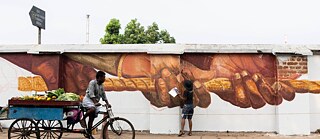And the Protests
Female Street Art

Street art in India is as much a form of art as a form of protest. Particularly for women. It strengthens their role in society.
By Oliver Schulz
India has produced some of the world’s more creative and innovative women street artists. Many of them no longer work illegally but with the permission of urban property owners.

Today, you come across gigantic and colourful wall paintings in almost all the large cities – not just in the country’s financial capital. Many have been painted by women. Besides Anpu Varkey, the most well-known names include Jas Charanjiva, Kajal Singh, Jheel Goradia and Avantika Mathur. Some have also worked in cities in the West.
As old as India
Street art is not new in India. In fact, art historians claim that it is as old as the country itself. Even the traditional Madhubani and Gond paintings can be traced back to the art of painting on mud walls.
Modern graffiti art has its origins in the 1960s in the East Coast of the United States. The differences between graffiti and street art are fluid, but while graffiti essentially serves to mark one’s territory, many street artists seek to voice an opinion, above all, and to communicate with the people.
Direct response to the work

Even though street art is now an established art form, many women artists continue to paint walls without permission. This is risky, of course. The biggest danger lies in being caught by the police. “I was almost put behind bars because I had ‘ruined’ our country,” says Jheel Ghoradia. “I don’t think we deserve such treatment when we actually beautify walls soaked with urine or full of paan stains.”
Many women street artists are smashing stereotypes simply by being women who practise this art form. For some, it is a direct form of protest. For instance, following the gang rape in Delhi in 2013, Jas Charanjiva painted an image of an Indian woman on a wall. All in pink and traditionally dressed. In her right hand, she had a brass knuckle that said ‘boom’. The painting immediately went viral. After the rape, the Fearless Collective project also came into being in New Delhi and street art is part of the programme. The aim is to strengthen the role of women in society through public art.
Festivals throughout India since the 2000s
Women discovered the art form for themselves at the start of the 2000s. More and more graffiti writing by local artists were appearing in Delhi. In 2001, the well-known graffiti artist Daku spray painted nine buildings in Mumbai overnight. He wanted to protest against the police crackdown on Mumbai’s bars and pubs. Artists’ collectives were being formed throughout India and were leaving a mark in the form of wall murals in public spaces.The graffiti and street art scene exploded in Delhi as of 2008. At the street art festival in an unauthorised part of Khirkee Extension in 2012, some residents also joined professional artists in painting on the walls. Street art festivals followed in cities such as Chennai, Pune, and Pondicherry. In Mumbai in March 2019, the programme included the first women-only street art festival – Ladies First. Women artists spent a week painting buildings and walls covering an area of 1000 sq m.
Essentially a bourgeois art form

In reality, however, what this art form has always lacked is a genuine street scene. Since its early days, street art in India has been an extremely bourgeois art form with many of the artists belonging to the upper-middle class. After all, it is not exactly cheap to paint city walls. A can of spray paint costs the equivalent of almost six euros (about 450 Rupees). Not something real street children can afford.